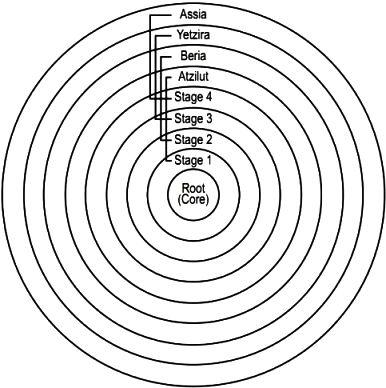How Desires Become Worlds
Continuing the Partzuf/company allegory, the company, a.k.a. “Creation,” begins to sort out the “unemployed” desires on its waiting list, placing the weakest, easiest to handle desires at the top of the list, and the most intense, unruly ones at the bottom. Creation divides these desires into four categories, similar to the four stages in the evolution of desires. It refers to each category as an Olam (world), from the Hebrew word Haalama (concealment), since these desires must be kept separated and concealed from the lights until they can be operated correctly—with the aim to bestow. Thus, the desires with qualities most similar to Stage One are called “the world of Atzilut,” those most similar to Stage Two form “the world of Beria,” with those most similar to Stage Three forming “the world of Yetzira,” and those most similar to Stage Four becoming “the world of Assiya” (Figure no. 8). For short, they are called “ABYA.”
Four Worlds Akin to Four Stages
Figure no. 8: Creation divides the remaining desires into four categories, akin to the four stages of the evolution of desires. It refers to each category as an Olam (world), from the Hebrew word Haalama (concealment).
When Kabbalists describe the spiritual realm—where desires work with the aim to bestow—they usually divide it into worlds and describe what happens in them (how desires actually receive). Therefore, they often refer to everything that precedes the worlds of ABYA as a world as well, and call it “the world of AK” (Adam Kadmon—the primordial man). In a way, the world of AK parallels the Root Stage, or Stage Zero, in the evolution of desires.
Note that our world is not mentioned among the spiritual worlds. Because our world is based on egoism, and the worlds in Kabbalah reflect levels of bestowal, our world is not considered part of the spiritual (with the aim to bestow) system.
The spiritual system is ceaselessly evolving through interaction among its forces, gradually making more of its desire capable of receiving with the aim to bestow, building each stage on conclusions and actions performed in its preceding stages. Similarly, as a baby grows, its physical and cognitive abilities develop by building on previously acquired capabilities and observations. Without going through these early stages of development, babies would not become adults. Of course, we do not, and need not keep those early-life observations in our consciousness while we go about our daily routine, since they have become automatic; yet, we constantly use them in our lives as adults.
With children, we help them acquire new capabilities and data, and we watch over them to make certain that they do not attempt to do things prematurely. Similarly, to complete creation’s “maturing” into being Creator-like, it needs to learn with which of its desires it can work (receive in order to bestow), as well as how and with which desires it still cannot work because it would reawaken the sense of inferiority and shame.
Hence, in each world, Creation carefully examines the light (pleasure) that the desire to give wished to impart on it. In Atzilut, Creation receives all the light, since Atzilut corresponds to the desire of Stage One—receiving all the light “automatically,” not getting its own desire to receive involved. For this reason, the desire-pleasure combination in Atzilut is called “still” or “inanimate,” since the desire is passive, still.
In Beria, creation receives less light because Beria corresponds to Stage Two, which is a more developed state of the desire to receive—a desire to give, like the Creator. Because Beria corresponds to the first desire that reacted to the light, it was given the name of the first level of life: “vegetative.”
In Yetzira, Creation receives even less light than in Beria because Yetzira corresponds to Stage Three in the desire to receive, which received only a little bit of light to begin with (look back to Chapter 2, section “Four Stages and the Root of Creation”). Still, it is a more developed stage in the evolution of the desire to receive, showing a certain measure of autonomy. For this reason, it received the name of the level in evolution whose members display at least some autonomy—“animate.”
In Assiya, Creation receives so little of the light that it is not sensed as pleasure whatsoever, but as mere sustenance. Assiya corresponds to Stage Four in the evolution of desires, and just as Stage Four experienced the restriction, the world of Assiya is barred from experiencing the light. But because it corresponds to the latest, most developed, and most complex level of desire, it received the name of its corporeal parallel: “human” or “speaking.”

